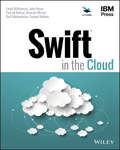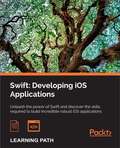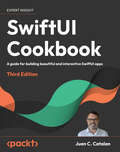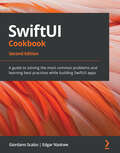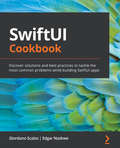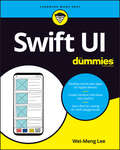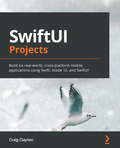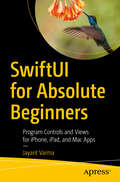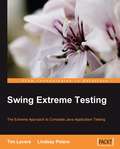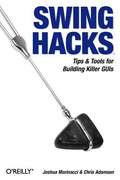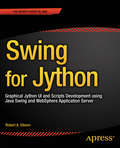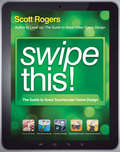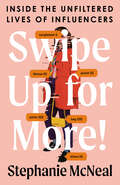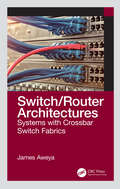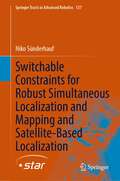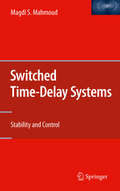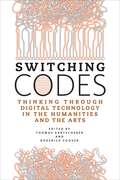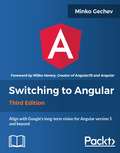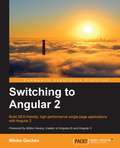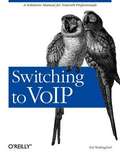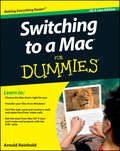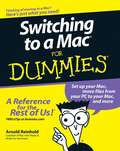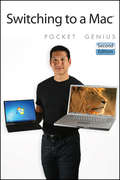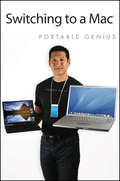- Table View
- List View
Swift in the Cloud
by John Ponzo Karl Weinmeister Leigh Williamson Patrick Bohrer Ricardo Olivieri Samuel KallnerWrite and run Swift language programs in the Cloud Written by the team of developers that has helped bring the Swift language to Cloud computing, this is the definitive guide to writing and running Swift language programs for cloud environment. In Swift in the Cloud, you'll find full coverage of all aspects of creating and running Swift language applications in Cloud computing environments, complete with examples of real code that you can start running and experimenting with today. Since Apple introduced the Swift language in 2014, it has become one of the most rapidly adopted computer programming languages in history—and now you too can start benefitting from using the same programming language for all components of a scalable, robust business software solution. Create server applications using Swift and run them on pay-as-you-go cloud infrastructure Quickly write and test Swift code snippets in your own cloud sandbox Use Docker containers to deploy Swift applications into multiple cloud environments without having to change code Grasp the elements and structure of the Swift.org open technology project Find out how to avoid the complexities of runtime configuration by using Cloud Foundry buildpacks for Swift Build high performing web applications and REST APIs with an open source Swift based web server framework Scale up your cloud services by running Swift modules in an asynchronous, open source, 'serverless' cloud environment Whether you are already using Swift to build mobile applications or a seasoned web developer, Swift in the Cloud will help you leverage server-side Swift to power your next generation of applications.
Swift: Developing iOS Applications
by Jon Hoffman Giordano Scalzo Andrew J WagnerUnleash the power of Swift and discover the skills required to build incredible robust iOS applications About This Book * Write expressive, understandable, and maintainable Swift 2 code with this hands-on course * Unveil the complex underpinnings of Swift to turn your app ideas into reality * Specialize in developing real iOS apps, and 2D and 3D video games using Swift and Cocoapods * Dive deep into protocol extensions, learn new error handling model and use featured Swift design patterns to write more efficient code Who This Book Is For This course would be for app developers who are new to developing for iOS or OSX and are trying to get grips with Swift for the first time. What You Will Learn * From a solid understanding of the Swift 2 language * Get to know the practical aspects of how a computer program actually works * Understand the paradigms used by Apple's frameworks, so you are not intimidated by them * Create a server in Swift to deliver JSON data to an iOS app * Take advantage of Cocoapods to use third-party libraries * Build games with SpriteKit and SceneKit * Develop an app running on the cloud to act as an API server for your client's apps * Dive into the core components of Swift 2 including operators, collections, control flow, and functions * Create and use classes, structures, and enums including object-oriented topics such as inheritance, protocols, and extensions * Develop a practical understanding of subscripts, optionals, and closures * Master Objective-C interoperability with mix and match * Access network resources using Swift * Implement various standard design patterns in the Swift language In Detail The Swift--Developing iOS Applications course will take you on a journey to become an efficient iOS and OS X developer, with the latest trending topic in town. Right from the basics to the advanced level topics, this course would cover everything in detail. We'll embark our journey by dividing the learning path into four modules. Each of these modules are a mini course in their own right; and as you complete each one, you'll gain key skills and be ready for the material in the next module. The first module is like a step-by-step guide to programming in Swift 2. Each topic is separated into compressible sections that are full of practical examples and easy-to-understand explanations. Each section builds on the previous topics, so you can develop a proficient and comprehensive understanding of app development in Swift 2. By the end of this module, you'll have a basic understanding of Swift 2 and its functionalities. The second module will be the an easy-to-follow guide filled with tutorials to show you how to build real-world apps. The difficulty and complexity level increases chapter by chapter. Each chapter is dedicated to build a new app, beginning from a basic and unstyled app through to a full 3D game. The last two chapters show you how to build a complete client-server e-commerce app right from scratch. You'll be able to build well-designed apps, effectively use AutoLayout, develop videogames, and build server apps. The third and the last module of our course will take an example-based approach where each concept covered is supported by example code to not only give you a good understanding of the concept, but also to demonstrate how to properly implement it. Style and approach This course includes all the resources that will help you jump into the app development .This course covers all the important aspects Swift application development and is divided into individual modules so that you develop your skill after the completion of a module and get ready for the next. Through this comprehensive course, you'll learn how to use Swift programming with hands-on examples from scratch to finish!
SwiftUI Cookbook: A guide for building beautiful and interactive SwiftUI apps
by Juan C. CatalanExperience the potential of SwiftUI, Swift 5.9, and Xcode 15 for crafting cutting-edge apps on iOS 17, macOS 14.0 Sonoma, and watchOS 10Key FeaturesUnlock advanced controls and animations with SwiftUI 5, taking your app development skills to the next levelVisualize data effortlessly using Swift Charts enhancing your app's data-driven capabilitiesDevelop for multiple platforms, including iOS, macOS, and watchOS, and become a versatile app developerPurchase of the print or Kindle book includes a free PDF eBookBook DescriptionSwiftUI is the modern way to build user interfaces for iOS, macOS, and watchOS. It provides a declarative and intuitive way to create beautiful and interactive user interfaces. The new edition of this comprehensive cookbook includes a fully updated repository for SwiftUI 5, iOS 17, Xcode 15, and Swift 5.9. With this arsenal, it teaches you everything you need to know to build beautiful and interactive user interfaces with SwiftUI 5, from the basics to advanced topics like custom modifiers, animations, and state management. In this new edition, you will dive into the world of creating powerful data visualizations with a new chapter on Swift Charts and how to seamlessly integrate charts into your SwiftUI apps. Further, you will be able to unleash your creativity with advanced controls, including multi-column tables and two-dimensional layouts. You can explore new modifiers for text, images, and shapes that give you more control over the appearance of your views. You will learn how to develop apps for multiple platforms, including iOS, macOS, watchOS, and more. With expert insights, real-world examples, and a recipe-based approach, you’ll be equipped to build remarkable SwiftUI apps that stand out in today’s competitive market.What you will learnCreate stunning, user-friendly apps for iOS 17, macOS 14, and watchOS 10 with SwiftUI 5Use the advanced preview capabilities of Xcode 15Use async/await to write concurrent and responsive codeCreate powerful data visualizations with Swift ChartsEnhance user engagement with modern animations and transitionsImplement user authentication using Firebase and Sign in with AppleLearn about advanced topics like custom modifiers, animations, and state managementBuild multi-platform apps with SwiftUIWho this book is forThis book is for mobile developers who want to learn SwiftUI as well as experienced iOS developers transitioning from UIKit to SwiftUI. The book assumes knowledge of the Swift programming language. Knowledge of object-oriented design and data structures will be useful but not necessary. You'll also find this book to be a helpful resource if you're looking for reference material regarding the implementation of various features in SwiftUI.
SwiftUI Cookbook: A guide to solving the most common problems and learning best practices while building SwiftUI apps, 2nd Edition
by Giordano Scalzo Edgar NzokweFind practical, logical, and efficient recipes for building cross-platform apps for iOS 15, macOS, and watchOS using Swift 5.5, Xcode 13, and SwiftUI 3.0Key FeaturesApply the declarative programming paradigm to build cross-platform UIs for Apple devicesLearn to integrate UIkit, Core Data, Firebase, and Sign in with Apple with SwiftUIAdopt the new SwiftUI 3.0 features to build visually appealing UIs speedilyBook DescriptionSwiftUI provides an innovative and simple way to build beautiful user interfaces (UIs) for all Apple platforms, from iOS and macOS through to watchOS and tvOS, using the Swift programming language. In this recipe-based cookbook, you'll cover the foundations of SwiftUI as well as the new SwiftUI 3 features introduced in iOS 15 and explore a range of essential techniques and concepts that will help you through the development process.The cookbook begins by explaining how to use basic SwiftUI components. Once you've learned the core concepts of UI development, such as Views, Controls, Lists, and ScrollViews, using practical implementations in Swift, you'll advance to adding useful features to SwiftUI using drawings, built-in shapes, animations, and transitions. You'll understand how to integrate SwiftUI with exciting new components in the Apple development ecosystem, such as Combine for managing events and Core Data for managing app data. Finally, you'll write iOS, macOS, and watchOS apps by sharing the same SwiftUI codebase.By the end of this SwiftUI book, you'll have discovered a range of simple, direct solutions to common problems encountered when building SwiftUI apps.What you will learnExplore various layout presentations in SwiftUI such as HStack, VStack, LazyHStack, and LazyVGridCreate widgets to quickly display relevant content at glanceGet up to speed with drawings in SwiftUI using built-in shapes, custom paths, and polygonsDiscover modern animation and transition techniques in SwiftUIAdd user authentication using Firebase and Sign in with AppleManage concurrency with Combine and async/await in SwiftUISolve the most common SwiftUI problems, such as integrating a MapKit map, unit testing, snapshot testing, and previewing layoutsWho this book is forThis book is for mobile developers who want to learn SwiftUI as well as experienced iOS developers transitioning from UIkit to SwiftUI. The book assumes knowledge of the Swift programming language. Knowledge of object-oriented design and data structures will be useful but not necessary. You'll also find this book to be a helpful resource if you're looking for reference material regarding the implementation of various features in SwiftUI.
SwiftUI Cookbook: Discover solutions and best practices to tackle the most common problems while building SwiftUI apps
by Giordano Scalzo Edgar NzokweThis book is for mobile developers who want to learn SwiftUI as well as experienced iOS developers transitioning from UIKit to SwiftUI. The book assumes knowledge of the Swift programming language. Knowledge of object-oriented design and data structures is useful but not necessary.
SwiftUI For Dummies
by Wei-Meng LeeThe simplest way to create world-class apps Have a unique app idea but worried you don’t quite have the coding skills to build it? Good news: You can stop fretting about someone beating you to market with the same idea and start work right now using SwiftUI. SwiftUI is a gateway app development framework that has become one of the best ways for fledgling developers to get iOS apps off the ground without having to become a coding expert overnight. SwiftUI For Dummies makes that process even faster, providing a friendly introduction to the SwiftUI and Swift programming language and helping you feel right at home creating and building with playgrounds. The book also covers the frameworks and APIs that make it so easy to create smooth, intuitive interfaces—just dive right in and have fun! Combine projects into workspaces Employ Xcode editing tools Use constants and variables Test your code on iOS Simulator Time is of the essence, and with SwiftUI For Dummies, it’s also on your side. Get going with this friendly guide today, and you’ll be celebrating the successful launch of your app way before you thought possible!
SwiftUI Projects: Build six real-world, cross-platform mobile applications using Swift, Xcode 12, and SwiftUI
by Craig ClaytonLearn SwiftUI by designing and building complex user interfaces for watchOS, iPadOS, and iOS with the help of projects including a financial app, a sports news app, and a POS systemKey FeaturesLearn SwiftUI with the help of practical cross-platform development projectsUnderstand the design considerations for building apps for different devices such as Apple Watch, iPhone, and iPad using SwiftUI's latest featuresWork with advanced SwiftUI layout features, including SF Symbols, SwiftUI grids, and forms in SwiftUIBook DescriptionReleased by Apple during WWDC 2019, SwiftUI provides an innovative and exceptionally simple way to build user interfaces for all Apple platforms with the power of Swift.This practical guide involves six real-world projects built from scratch, with two projects each for iPhone, iPad, and watchOS, built using Swift programming and Xcode. Starting with the basics of SwiftUI, you'll gradually delve into building these projects. You'll learn the fundamental concepts of SwiftUI by working with views, layouts, and dynamic types. This SwiftUI book will also help you get hands-on with declarative programming for building apps that can run on multiple platforms. Throughout the book, you'll work on a chart app (watchOS), NBA draft app (watchOS), financial app (iPhone), Tesla form app (iPhone), sports news app (iPad), and shoe point-of-sale system (iPad), which will enable you to understand the core elements of a SwiftUI project.By the end of the book, you'll have built fully functional projects for multiple platforms and gained the knowledge required to become a professional SwiftUI developer.What you will learnUnderstand the basics of SwiftUI by building an app with watchOSWork with UI elements such as text, lists, and buttonsCreate a video player in UIKit and import it into SwiftUIDiscover how to leverage an API and parse JSON in your app using CombineStructure your app to use Combine and state-driven featuresCreate flexible layouts on iPadWho this book is forSwiftUI Projects is intended for anyone who is already comfortable with Swift. We do not cover Swift topics in detail, so you need to be familiar with these already. All of the SwiftUI topics are taught as if this is the first time you've learned them and will gradually get more difficult.
SwiftUI for Absolute Beginners: Program Controls and Views for iPhone, iPad, and Mac Apps
by Jayant VarmaDive into the world of developing for all of Apple platforms with SwiftUI, Apple’s new framework that makes writing applications faster and easier with fewer lines of code. This book teaches the basics of SwiftUI to help you write amazing native applications using XCode.For developers already familiar with ReactNative, this book reviews the declarative, state-based DSL that manages the UI and updates it automatically will feel just like what they’re used to. You'll see how SwiftUI reduces the number of lines of code required to achieve the same effects by over 60% and provides a much better experience. Like the announcement of Swift in 2014, SwiftUI is expected to fundamentally change the way developing programmers approach coding iPhone and iPad applications. This book examines how SwiftUI lowers the entry barrier for developers to write amazing cross-platform applications for iOS and iPadOS as well as WatchOS, Mac OS, and TVOS. What You'll LearnWrite code in the new SwiftUI syntaxCombine views to arrange them for an applicationAdd gestures and controls to an applicationWho This Book Is ForAnyone who wants to learn to develop apps for the Mac, iPhone, iPad, and Apple Watch using the Swift programming language. No previous programming experience is necessary.
Swing Extreme Testing
by Tim Lavers Lindsay PetersThis book is a practical guide based on the authors daily experience developing and maintaining a cutting-edge Artificial Intelligence system. Every chapter comes up with real-life examples and the source code that comes with the book is full of useful (and well-tested) tools. The practical examples make this book suitable learning material for Swing developers. This book is for Swing developers who design and develop complex software for user interfaces that requires extensive testing. If you want to learn to test your Swing GUI components, this book is for you.
Swing Hacks
by Chris Adamson Joshua MarinacciSwing Hacks helps Java developers move beyond the basics of Swing, the graphical user interface (GUI) standard since Java 2. If you're a Java developer looking to build enterprise applications with a first-class look and feel, Swing is definitely one skill you need to master. This latest title from O'Reilly is a reference to the cool stuff in Swing. It's about the interesting things you learn over the years--creative, original, even weird hacks--the things that make you say, "I didn't know you could even do that with Swing!" Swing Hacks will show you how to extend Swing's rich component set in advanced and sometimes non-obvious ways. The book touches upon the entire Swing gamut-tables, trees, sliders, spinners, progress bars, internal frames, and text components. Detail is also provided on JTable/JTree, threaded component models, and translucent windows. You'll learn how to filter lists, power-up trees and tables, and add drag-and-drop support. Swing Hacks will show you how to do fun things that will directly enhance your own applications. Some are visual enhancements to make your software look better. Some are functional improvements to make your software do something it couldn't do before. Some are even just plain silly, in print only to prove it could be done. The book will also give you give you a small glimpse of the applications coming in the future. New technology is streaming into the Java community at a blistering rate, and it gives application developers a whole new set of blocks to play with. With its profusion of tips and tricks, Swing Hacks isn't just for the developer who wants to build a better user interface. It's also ideally suited for client-side Java developers who want to deliver polished applications, enthusiasts who want to push Java client application boundaries, and coders who want to bring powerful techniques to their own applications. Whatever your programming needs, Swing Hacks is packed with programming lessons that increase your competency with interface-building tools.
Swing for Jython
by Robert A. GibsonThis book shows you how to use Swing to add a GUI to your Jython scripts, with an emphasis on the WebSphere Application Server wsadmin utility. In fact, we're going to teach you Swing using Jython, and we're going to do it in a way that, hopefully, that makes your scripts easier for people to use, more robust, more understandable, and therefore easier to maintain.
Swipe This!
by Scott RogersLearn to design games for tablets from a renowned game designer!Eager to start designing games for tablets but not sure where to start? Look no further! Gaming guru Scott Rogers has his finger on the pulse of tablet game design and is willing to impart his wisdom and secrets for designing exciting and successful games. As the creator of such venerable games as God of War, the SpongeBob Squarepants series, and Pac-Man World, to name a few, Rogers writes from personal experience and in this unique book, he hands you the tools to create your own tablet games for the iPad, Android tablets, Nintendo DS, and other touchscreen systems.Covers the entire tablet game creation process, placing a special focus on the intricacies and pitfalls of touch-screen game designExplores the details and features of tablet game systems and shows you how to develop marketable ideas as well as market your own gamesOffers an honest take on what perils and pitfalls await you during a game's pre-production, production, and post-production stagesFeatures interviews with established tablet game developers that serve to inspire you as you start to make your own tablet game designSwipe This! presents you with an in-depth analysis of popular tablet games and delivers a road map for getting started with tablet game design.
Swipe Up for More!: Inside the Unfiltered Lives of Influencers
by Stephanie McNealAn unfiltered, colorful romp through the IRL world of influencers that spills the tea on the multibillion-dollar industry of content creation.If you&’re anything like journalist Stephanie McNeal—aka, a millennial woman—you spend hours every day indulging in Instagram&’s infinite scroll. The influencers on the platform aren&’t just providing eye candy; these tastemakers impact how we cook, consume, parent, decorate, think, and live. But what exactly is going on behind the curtain of the perfectly curated Instagram grids we obsess over the most? Through intimate, funny, and vulnerable reporting, McNeal takes us through the looking glass and into the secretive real world of three major influencers: fashion and lifestyle juggernaut Caitlin Covington of Southern Curls & Pearls, runner and advocate Mirna Valerio, and OG &“mommy blogger&” Shannon Bird. Swipe Up For More! is based on three years of unprecedented, fly-on-the-wall access that offers a rare glimpse into how these influencers build their empires, struggle with the haters and snarkers, fight for creative control from the tech platforms that enable their businesses, parent in public, and try to look good while doing it.Along the way, McNeal answers burning questions, like: Why are there so many Mormon mommy influencers? What is it like to work for a popular influencer? What do they do with all the free swag? How do brand partnerships work? And how much money do they really make?Irresistible, juicy, and voyeuristic, Swipe Up For More! reveals all about the women some love to hate (and many actually, secretly, genuinely love).
Switch/Router Architectures: Systems with Crossbar Switch Fabrics
by James AweyaCrossbar switch fabrics offer many benefits when designing switch/routers. This book discusses switch/router architectures using design examples and case studies of well-known systems that employ crossbar switch fabric as their internal interconnects. This book looks to explain the design of switch/routers from a practicing engineer’s perspective. It uses a broad range of design examples to illustrate switch/router designs and provides case studies to enhance readers comprehension of switch/router architectures. The book goes on to discuss industry best practices in switch/router design and explains the key features and differences between unicast and multicast packet forwarding architectures. This book will be of benefit to telecoms/networking industry professionals and engineers as well as researchers and academics looking for more practical and efficient approaches for designing non-blocking crossbar switch fabrics.
Switchable Constraints for Robust Simultaneous Localization and Mapping and Satellite-Based Localization (Springer Tracts in Advanced Robotics #137)
by Niko SünderhaufSimultaneous Localization and Mapping (SLAM) has been a long-standing research problem in robotics. It describes the problem of a robot mapping an unknown environment, while simultaneously localizing in it with the help of the incomplete map. This book describes a technique called Switchable Constraints.Switchable Constraints help to increase the robustness of SLAM against data association errors and in particular against false positive loop closure detections. Such false positive loop closure detections can occur when the robot erroneously assumes it re-observed a landmark it has already mapped or when the appearance of the observed surroundings is very similar to the appearance of other places in the map. Ambiguous observations and appearances are very common in human-made environments such as office floors or suburban streets, making robustness against spurious observations a key challenge in SLAM. The book summarizes the foundations of factor graph-based SLAM techniques. It explains the problem of data association errors before introducing the novel idea of Switchable Constraints. We present a mathematical derivation and probabilistic interpretation of Switchable Constraints along with evaluations on different datasets. The book shows that Switchable Constraints are applicable beyond SLAM problems and demonstrates the efficacy of this technique to improve the quality of satellite-based localization in urban environments, where multipath and non-line-of-sight situations are common error sources.
Switched Time-Delay Systems
by Magdi S. MahmoudThis book is about stability analysis and control design methodologies for a new class of systems, switched time-delay systems (STDs). The author presents an introductory, yet comprehensive, treatment of STD systems by jointly combining the two fundamental attributes: the system dynamics which possesses an inherent time-delay and the system operational mode which undergoes switching among different modes. The material integrates the two main issues of switched systems in a systematic way.
Switching Codes: Thinking Through Digital Technology in the Humanities and the Arts
by Thomas Bartscherer Roderick CooverHalf a century into the digital era, the profound impact of information technology on intellectual and cultural life is universally acknowledged but still poorly understood. The sheer complexity of the technology coupled with the rapid pace of change makes it increasingly difficult to establish common ground and to promote thoughtful discussion. Responding to this challenge, Switching Codes brings together leading American and European scholars, scientists, and artists--including Charles Bernstein, Ian Foster, Bruno Latour, Alan Liu, and Richard Powers--to consider how the precipitous growth of digital information and its associated technologies are transforming the ways we think and act. Employing a wide range of forms, including essay, dialogue, short fiction, and game design, this book aims to model and foster discussion between IT specialists, who typically have scant training in the humanities or traditional arts, and scholars and artists, who often understand little about the technologies that are so radically transforming their fields. Switching Codes will be an indispensable volume for anyone seeking to understand the impact of digital technology on contemporary culture, including scientists, educators, policymakers, and artists, alike.
Switching and Finite Automata Theory
by Niraj K. Jha Zvi KohaviUnderstand the structure, behavior, and limitations of logic machines with this thoroughly updated third edition. Many new topics are included, such as CMOS gates, logic synthesis, logic design for emerging nanotechnologies, digital system testing, and asynchronous circuit design, to bring students up-to-speed with modern developments. The intuitive examples and minimal formalism of the previous edition are retained, giving students a text that is logical and easy to follow, yet rigorous. Kohavi and Jha begin with the basics, and then cover combinational logic design and testing, before moving on to more advanced topics in finite-state machine design and testing. Theory is made easier to understand with 200 illustrative examples, and students can test their understanding with over 350 end-of-chapter review questions.
Switching to Angular - Third Edition
by Minko GechevSwitching to Angular, Third Edition is the go-to book to align and get started with the Angular JavaScript framework. Angular contributor and international speaker Minko Gechev will help you square up and start building Angular apps and provide you an insight to the Google's vision for the framework. About This Book • Get up to date with Google's vision for Angular • Align with Angular version 5 and beyond from any direction with confidence • Start using TypeScript to supercharge your Angular applications • Understand the new framework from AngularJS perspective using your prior experience • Use Angular to quickly build fast and scalable enterprise applications Who This Book Is For This book is for software developers who want to align with a modern version of Angular that's aligned with Google's vision of Angular version 5 and beyond, using stable APIs that they can depend on today and in the future. Also for anyone assessing changes to Angular and squaring up for a strategic migration to Angular v5, and for AngularJS developers who want to transfer their mindset to modern Angular version 5 and beyond. What You Will Learn • Align with Google's vision for Angular version 5 and beyond • Confidently move forwards with a long-term understanding of Angular • Use stable APIs in Angular to build future-proof, blazingly fast, enterprise applications • Work with TypeScript to supercharge your Angular applications • Understand the core concepts of Angular, aligned with the vision from Google • Be ready with Angular from any direction - whether you're building new new apps with the Angular and ASP.NET stack or upgrading from AngularJS with ngUpgrade In Detail Align your work to stable APIs of Angular, version 5 and beyond, with Angular expert Minko Gechev. Angular is the modern Google framework for you to build high-performing, SEO-friendly, and robust web applications. Switching to Angular, Third Edition shows you how you can align your current and future development with Google's long term vision for Angular. Gechev shares his expert knowledge and community involvement to give you the clarity you need to confidently switch into Angular and stable APIs. Minko Gechev helps you square up to Angular with an overview of the framework, and understand the long term building blocks of Google's web framework. Gechev then gives you the lowdown on TypeScript, with a crash-course so you can take advantage of Angular in its native, statically-typed environment. You'll next move on to see how you can line up with Angular dependency injection, plus how Angular router and forms, and Angular pipes, are designed to work for your projects today and in the future. You'll be squared up and aligned with the vision and techniques of the one Angular, and be ready to start building quick and efficient Angular applications. You'll know how to take advantage of the latest Angular features, and the core, stable APIs that you can depend on. You'll be ready to confidently plan your future with the Angular framework. Style and approach In this book, Minko Gechev continues his direct style of sharing knowledge about Angular that he's developed across more than 40 international presentations to Angular developers. First, Minko explains Google's vision of Angular to you, and then you dive into a clear tutorial to work with Angular that's aligned with Google's vision of Angular.
Switching to Angular 2
by Minko GechevBuild SEO-friendly, high-performance single-page applications with Angular 2 About This Book * Get up to date with the latest changes to Angular 2, including the improvements to directives, change detection, dependency injection, router, and more * Understand Angular 2's new component-based architecture * Start using TypeScript to supercharge your Angular 2 applications Who This Book Is For Do you want to jump in at the deep end of Angular 2? Or perhaps you're interested assessing the changes before moving over? If so, then Switching to Angular 2 is the book for you. To get the most out of the book, you'll need to be familiar with AngularJS 1.x, and have a good understanding of JavaScript. No knowledge of the changes made to Angular 2 is required follow along. What You Will Learn * Understand the changes made from Angular 1.x with side-by-side code samples to help demystify the Angular 2 learning curve * Start working with Angular 2's new method of implementing directives * Use TypeScript to write modern, powerful Angular 2 applications * Dig in to the change-detection method, and other architectural changes to make sure you know what's going on under the hood of Angular 2. * Get to work with the new router in Angular 2 * Use the new features of Angular 2 including pipes, or the updated features such as forms, services, and the DI module * Master server-side rendering in Angular 2 to keep your new applications SEO friendly In Detail AngularJS is a JavaScript framework that makes building web applications easier. It is used today in large-scale, high-traffic websites that struggle with under-performance, portability issues, as well as SEO unfriendliness, and complexity at scale. Angular 2 changes that. It is the modern framework you need to build performant and robust web applications. "Switching to Angular 2" is the quickest way to get to grips with Angular 2 and will help you transition in to the brave new world of Angular 2. We'll start with an overview which sets the changes of the framework in context with version 1.x. After that, you will be taken on a TypeScript crash-course so we can take advantage of Angular 2 in its native, statically-typed environment. We'll look at the new change-detection method in detail, how Directives and Components change how you create websites with Angular, the new Angular 2 router, and much more. By the end of the book, you'll be ready to start building quick and efficient Angular 2 applications that take advantage of all the new features on offer. Style and approach Starting with a comparison between Angular versions that is filled with side-by-side code examples to help highlight the changes, each chapter then looks at major changes to the framework as is filled with small examples and sample code to get you started
Switching to VoIP
by Theodore WallingfordMore and more businesses today have their receive phone service through Internet instead of local phone company lines. Many businesses are also using their internal local and wide-area network infrastructure to replace legacy enterprise telephone networks. This migration to a single network carrying voice and data is called convergence, and it's revolutionizing the world of telecommunications by slashing costs and empowering users. The technology of families driving this convergence is called VoIP, or Voice over IP. VoIP has advanced Internet-based telephony a viable solution, piquing the interest of companies small and large. The primary reason for migrating to VoIP is cost, as it equalizes the costs of long distance calls, local calls, and e-mails to fractions of a penny per use. But the real enterprise turn-on is how VoIP empowers businesses to mold and customize telecom and datacom solutions using a single, cohesive networking platform. These business drivers are so compelling that legacy telephony is going the way of the dinosaur, yielding to Voice over IP as the dominant enterprise communications paradigm. Developed from real-world experience by a senior developer, O'Reilly's Switching to VoIP provides solutions for the most common VoIP migration challenges. So if you're a network professional who is migrating from a traditional telephony system to a modern, feature-rich network, this book is a must-have. You'll discover the strengths and weaknesses of circuit-switched and packet-switched networks, how VoIP systems impact network infrastructure, as well as solutions for common challenges involved with IP voice migrations. Among the challenges discussed and projects presented: building a softPBX configuring IP phones ensuring quality of service scalability standards-compliance topological considerations coordinating a complete system ?switchover? migrating applications like voicemail and directory services retro-interfacing to traditional telephony supporting mobile users security and survivability dealing with the challenges of NAT To help you grasp the core principles at work, Switching to VoIP uses a combination of strategy and hands-on "how-to" that introduce VoIP routers and media gateways, various makes of IP telephone equipment, legacy analog phones, IPTables and Linux firewalls, and the Asterisk open source PBX software by Digium. You'll learn how to build an IP-based or legacy-compatible phone system and voicemail system complete with e-mail integration while becoming familiar with VoIP protocols and devices. Switching to VoIP remains vendor-neutral and advocates standards, not brands. Some of the standards explored include: SIP H.323, SCCP, and IAX Voice codecs 802.3af Type of Service, IP precedence, DiffServ, and RSVP 802.1a/b/g WLAN If VoIP has your attention, like so many others, then Switching to VoIP will help you build your own system, install it, and begin making calls. It's the only thing left between you and a modern telecom network.
Switching to a Mac For Dummies
by Arnold ReinholdThinking of making the switch from your PC to a Mac? Congratulations! You're in for a great, virus-free ride. And Switching to Mac For Dummies makes it smoother than you ever imagined. From buying the Mac that's right for you to transferring your files to breaking your old Windows habits and learning to do things the (much easier) Mac way, it makes the whole process practically effortless.Whether you've been using Windows XP, Vista, or even Linux, you'll find simple, straightforward ways to make your transition go smoothly. That will leave you plenty of time to get familiar with Mac's prodigious and dynamic OS X capabilities. You'll also connect with iLife, Mac's amazing integrated software suite that lets you turn your computer into a powerful media center--not just for listening and watching, but for creating music, video, and much more. Discover how to:Decide whether the switch to Mac is right for youChoose the Mac that will change your lifeKeep and reuse elements of your old setupGo online with your MacConnect to your home network--even that old PCGo media crazy with iTunes, iPhoto and moreTake advantage of Mac's business capabilitiesComplete with handy cheat sheet of common Mac short cuts and commands as well as a glossary of Mac world lingo, Switching to Mac For Dummies ensures that your switch will be the smartest thing you ever do.
Switching to a Mac For Dummies
by Arnold ReinholdThinking of making the switch from your PC to a Mac? Congratulations! You’re in for a great, virus-free ride. And Switching to Mac For Dummies makes it smoother than you ever imagined. From buying the Mac that’s right for you to transferring your files to breaking your old Windows habits and learning to do things the (much easier) Mac way, it makes the whole process practically effortless. Whether you’ve been using Windows XP, Vista, or even Linux, you’ll find simple, straightforward ways to make your transition go smoothly. That will leave you plenty of time to get familiar with Mac’s prodigious and dynamic OS X capabilities. You’ll also connect with iLife, Mac’s amazing integrated software suite that lets you turn your computer into a powerful media center—not just for listening and watching, but for creating music, video, and much more. Discover how to: Decide whether the switch to Mac is right for you Choose the Mac that will change your life Keep and reuse elements of your old setup Go online with your Mac Connect to your home network—even that old PC Go media crazy with iTunes, iPhoto and more Take advantage of Mac’s business capabilities Complete with handy cheat sheet of common Mac short cuts and commands as well as a glossary of Mac world lingo, Switching to Mac For Dummies ensures that your switch will be the smartest thing you ever do.
Switching to a Mac Pocket Genius (Portable Genius #86)
by Paul McFedriesAn accessible guide to using a Mac or transitioning from Windows to Mac This book helps new-to-Mac users get more comfortable with their computers. Switching to a Mac Pocket Genius guides readers in learning more about their computers, including becoming familiar with the interface, performing routine tasks, and moving data. The author wants to help users get around Mac challenges and avoid or remedy common problems they encounter.
Switching to a Mac Portable Genius
by Paul McfedriesThe Genius is in.You don't have to be a genius to switch from a PC to a Mac. But if you want to make the move with less hassle, put this savvy Portable Genius guide to work. Want to share data between your Mac and your PC? Understand the differences between Mac OS®X and Windows®? Learn how to perform everyday Mac tasks? Transfer important stuff like calendars, contact lists, and music? You'll find cool and useful Genius tips, full-color screenshots, and pages of easy-to-access shortcuts and tools that will save you loads of time and let you enjoy your Mac to the max.Paul McFedries is the president of Logophilia Limited, a technical writing company. He has written more than four dozen books that have sold more than two million copies worldwide. These books include Macs Portable Genius, Teach Yourself VISUALLY Macs, and Teach Yourself VISUALLY Windows Vista. Paul encourages all readers to drop by his Web site, www.mcfedries.com.Portable GENIUS Fun, hip, and straightforward, the new Portable Genius series gives forward-thinking Apple users useful information in handy, compact books that are easy to navigate and don't skimp on the essentials. Collect the whole series and make the most of your Apple digital lifestyle.
